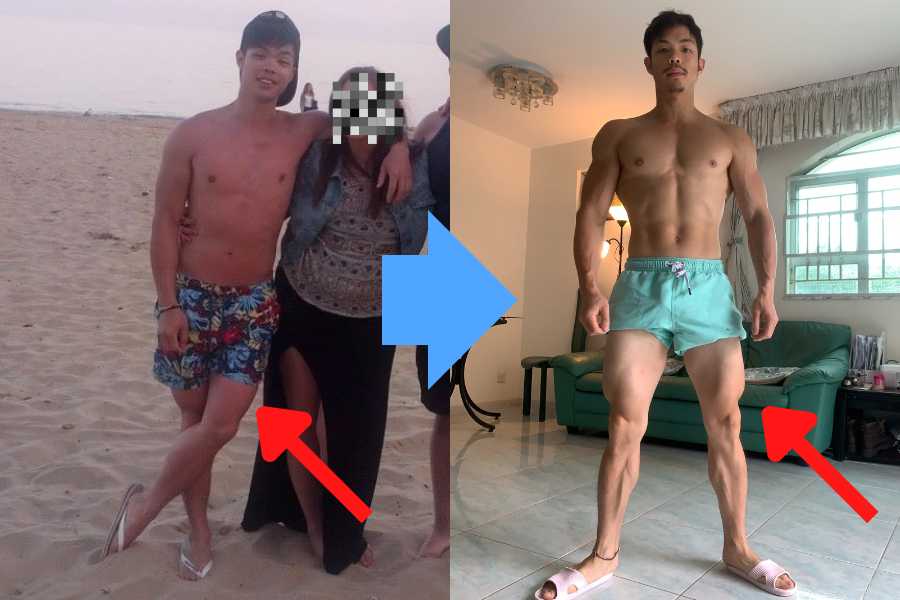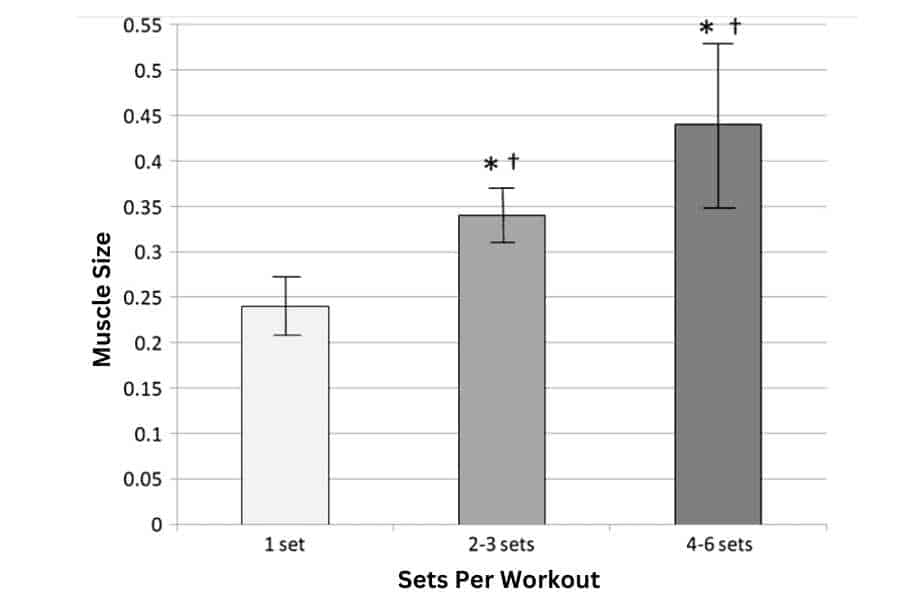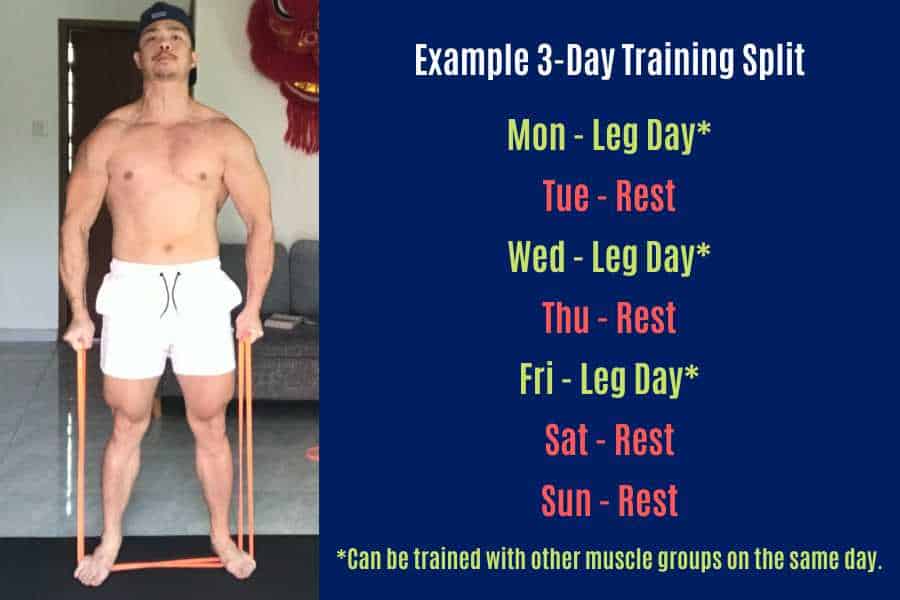Many people fall for one of two pitfalls when it comes to working the lower body; either overtraining or undertraining. So how often should you train your legs per week for the best results?
The average person should work their legs 2 to 3 times per week. This allows for 24 to 48 hours of rest between workouts. Each workout should be performed at a high intensity and include movements that target the quadriceps, hamstrings, glutes, and calves.
Leg workouts are fantastic for building muscle size, increasing strength, body toning, and improving overall fitness. It’s for this reason that they’re so popular with bodybuilders, powerlifters, and general fitness enthusiasts alike.
But speaking from experience, it’s essential to optimize your weekly leg day frequency to get the best results as fast as possible. That’s exactly what I’ll help you to do in this article!
Key takeaways:
- 2-3 intense leg workouts per week are sufficient to drive muscle growth.
- Aim to complete 10-15 sets per week targeting the leg muscles (if weight training).
- Do not forget to rest between workouts.
- Higher training frequencies are OK if the intensity is kept low.
- Watch out for signs of over/undertraining to further optimize training frequency.

Leg Day Frequency Definition
Training frequency refers to the number of workouts completed per week. Therefore leg day frequency means how often you spend working the lower-body muscles (quads, hams, glutes, and calves) in a given week.
Most people fall into one of three categories:
- Once weekly. Common with bodybuilders on a “Bro Split“. Here, you would hit each major muscle group (e.g. the legs) once per week using an extremely intense session. Also common with beginners who have just started a fitness program.
- 2 to 3 times weekly. Most popular training frequency. Here, you would hit each muscle group multiple times per week. Commonly adopted by beginners to advanced lifters alike.
- Daily. Here, you would train each muscle every day. Usually adopted by beginners under the misconception that “more work equals faster results” or people training for general fitness using low-intensity workouts.
Next, I’ll dive deeper into the science of the 2- to 3-day frequency and why it’s generally the best for building bigger and stronger legs.
Why 2-3 Days Is The Ideal Frequency For Legs
First, here’s a simple answer to the question:
“All muscles- including the legs- generally get bigger and stronger the more they are worked. However, muscles stop responding to training benefits once a certain workload is reached (per workout and per week). Furthermore, a muscle should be given enough time to rest in between workouts to repair and recover for the next session. Hitting your legs 2-3 times a day strikes the optimal balance between workload and recovery.”
Kalam Tang, M.S, Kalibre Fitness.
Secondly, here’s a more detailed (science-backed) answer:
This 2010 review concluded that muscles follow a dose-response to hypertrophy (growth) in trained and untrained subjects. In other words, the more you work a muscle the more it grows. This would suggest that working your legs every day would be ideal for growth. However, we know this is generally not the case.

Instead, the current consensus recommends dedicating 10-15 sets per week (and up to 20) on working your legs. This is known as the “maximum recoverable volume”. In other words, your leg muscles are no longer able to recover optimally after this threshold is surpassed, assuming you’re also lifting heavy weights. Now, there are two ways you can reach your 10-15 leg sets per week:
- Complete all sets in one workout (training legs once per week).
- Spread the sets over multiple workouts (training legs 2-3 times per week).
Speaking from personal experience, option 1 is difficult. After a certain amount of work has been completed on leg day, you become physically and mentally drained. Furthermore, a 2017 study found that most muscles stop responding to hypertrophy benefits after exceeding 6-sets in a given workout (so-called “wasted sets”).

Therefore option 2 is the better alternative for most people.
By spreading your 10-15 sets over multiple training days (2-3), you can reach the total training volume required to drive leg growth, give your legs the 24-48 hours required to rest and recover, and avoid the “wasted sets” zone.
Is It OK To Do More Than 3-2 Leg Days Per Week?
Most people will see the most benefits in hypertrophy and strength gains by completing 2-3 high-intensity leg workouts per week. For weight training, this usually means lifting a weight that’s more than 60% of the 1-rep max (1RM) for a given movement.
However, it’s OK to increase training frequency if you maintain a low intensity. This usually means lifting less than 60% of your 1RM.
It’s for this reason that beginners and casual exercises can train their legs every day without the negative consequences of overtraining. They’re simply not working their legs hard enough (per session). As a result, their quads/hams/glutes/calves are still able to recover in time for the next workout.
For more information, you may be interested in my case study that shows why you should not do high-intensity leg days every day.
Recommended Intensity For Legs
Working your legs multiple times per week is generally best for the average person. However, it’s essential to also consider training intensity for this weekly frequency to return the best benefits. In other words, you need to be training the leg muscles with enough weight for the workout to be productive.
Here are my recommendations based on your primary training goal:
| Category | Primary Goal | Recommended Weight | Recommended Reps |
|---|---|---|---|
| Powerlifters | Maximize strength & Power | 85-98% of 1RM | 1-6 reps per set |
| Bodybuilders | Build muscle size | 50-85% of 1RM | 8-15 reps per set |
| Cardio | Improve endurance | 40-50% of 1RM | 20+ reps per set |
Note: 1RM = 1 rep max. This is the maximum amount of weight you can lift for a given exercise. You can find your estimated 1 rep max for a variety of leg exercises using the Strength Level database.
I recommend completing 3-6 sets per workout in line with the previously recommended 10-15 sets per week. For example, 4 sets of barbell squats performed 3 times per week equals 12 total weekly sets targeting your quadriceps, hamstrings, glutes, and calves. Alternatively, 5 sets of leg extensions performed 2 times per week would give your quads 10 total weekly sets.
What If You’re Running Or Cycling?
The average person is recommended to run or cycle 2-3 times per week at a high intensity. This gives the lower body all the benefits of multiple weekly workouts and still allows enough time to recover between sessions.
Thus, similar principles apply regardless of whether you’re training the legs with running/cycling or weightlifting. The idea is to capitalize o the benefits of high-frequency training whilst still giving your leg muscles 24-48 hours of recommended rest in between sessions.
Here are general definitions of a high/low-intensity run/cycle:
- High intensity- sustaining >75% of your max heart rate for >10 mins.
- Low intensity- sustaining <75% of your max heart rate for <10 mins.
How Long A Lower-Body Workout Should Last
A high-intensity leg workout should generally last 10-20 minutes per session. Trained athletes can sustain longer training durations. But the average beginner-intermediate can complete an effective workload within a 20-minute time window with minimal risk of overtraining.
This accounts for the workload considerations recommended previously in this post.
Most people can fit their allotted weight training sets (for legs) into a 20-minute window. Additionally, a 20-minute run/cycle is more than sufficient to work the legs.
Signs Of Overtraining The Legs
Overtraining occurs when you exceed the maximum workload that your leg muscles can recover from. This can happen if workout intensity and/or frequency are too high.
Signs of overtraining include:
- Impaired recovery between workouts. Listen to your body. If your legs don’t feel fresh and ready for a workout, you may be training too much or too often.
- Decreased muscular strength. If you’re struggling to lift a weight that is normally manageable, then you may be overtraining.
- Excessive muscle soreness. Refer to point 1. Leg soreness is normal after an intense workout. But it should not be uncomfortable.
- Hypertrophy plateau. If you’re increasing your weekly leg workout frequency but not seeing additional gains in muscle size, then this is a big sign that you should reduce the number of leg days.
Signs Of Undertraining The Legs
Undertraining occurs when you fail to reach the workload required to promote size/strength/endurance gains in your leg muscles. This can happen if workout intensity and/or frequency are too low.
Signs of undertraining include:
- Low perceived level of exertion. An intense workout should increase your heart and breathing rates above resting levels. It may also lead to sweating.
- Stagnating progress. If you’re not seeing any benefits within a month, then chances are you’re not working your legs enough.
- Not completing the allotted number of weekly sets. The great thing about the recommendation to do 10-15 weekly sets is the standardization. If you’re lifting a sufficient amount of weight and increasing intensity as you become fitter (known as progressive overload), then you should see your legs getting bigger and stronger.
Conclusion
How often you should train your legs depends on a lot of factors (mainly fitness level and goal).
But for the average beginner-intermediate, 2-3 leg days per week are ideal for muscle growth, strength gains, and cardiovascular fitness.
Training intensity is also as important as frequency. You can follow my recommendations for weightlifting and running/cycling to make sure you’re working your legs hard enough!
You may also be interested in the downloadable Kalibre Blueprint PDF which details exactly how I gained 40lbs of lean muscle (it’s 100% free!). It details the exact exercises and nutrition (with printables) I used to go from skinny to ripped!


